Capto MMC
Capto MMC is a multimodal cation exchanger with the properties of a weak cation exchanger. In addition to electrostatic interactions, the ligand structure provides for additional interaction modes such as hydrophobic interaction, hydrogen bonding, and thiophilic interaction (Figure 3.8). The different possible interaction modes give the media novel selectivity and make it salt tolerant, which in turn allows sample to be loaded without dilution or a buffer exchange step, resulting in increased productivity.
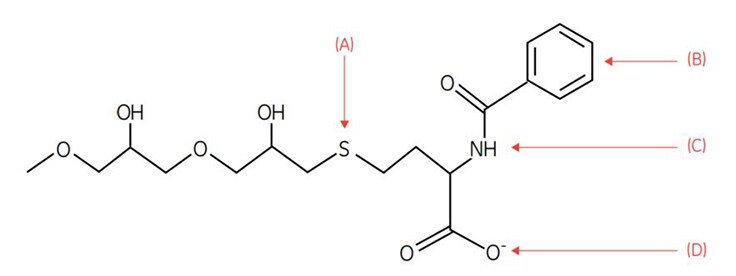
Figure 3.8. Capto MMC ligand. Interactions are shown by arrows: (A) for thiophilic; (B) for hydrophobic; (C) for hydrogen bonding; and (D) for electrostatic interactions.
Capto MMC is based on a highly rigid agarose base matrix that allows high flow rates and low back pressure at large scale, and is well-suited for fast, efficient and cost-effective protein purification. See also Figure 3.1 (Multimodal chromatography media) and its accompanying discussion of pressure-flow properties.
Capto MMC gives increased productivity and reduced cost with:
- high DBC even at high conductivity (binding of proteins can be performed at the conductivity of the feed material)
- high volume throughput
- new selectivity
- smaller unit operations (no dilution of feed material necessary, which leads to smaller tanks and faster operation)
High salt tolerance
The various interactions of Capto MMC medium described above provide characteristics different from traditional cation exchangers, including binding of proteins at high salt concentration (Figure 3.9). Capto MMC can therefore be used for direct load of feedstocks, without prior dilution or buffer exchange to reduce the conductivity of the starting material.
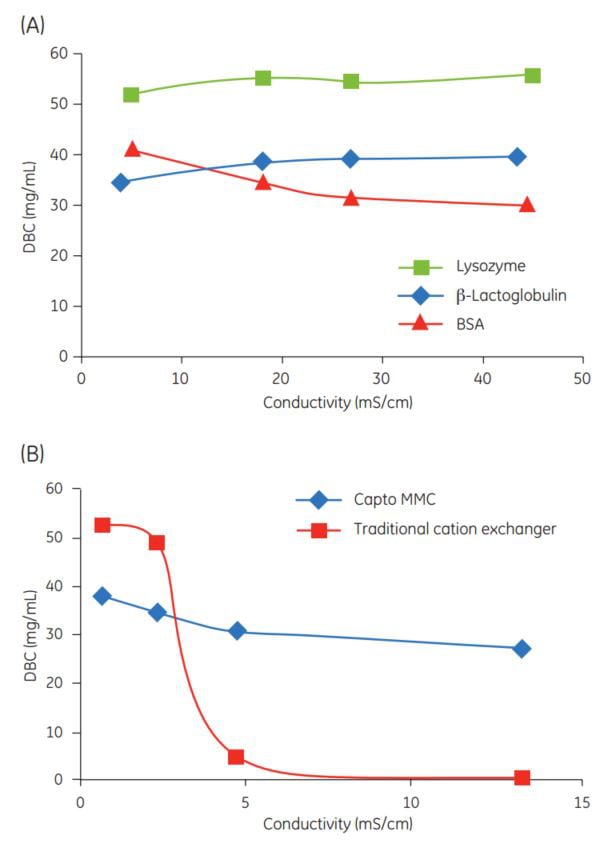
Figure 3.9. (A) DBC of Capto MMC at 1 min residence time for three different proteins at different conductivities. (B) Capto MMC allows a much larger operating range in terms of conductivity of the starting material than traditional cation exchangers.
Unique selectivity
The unique selectivity can also be used to solve specific purification problems, at high or low conductivity. A comparison between a traditional cation exchanger (SP Sepharose Fast Flow) and Capto MMC shows that the selectivity of the two media differs significantly (Figure 3.10). The elution profile on SP Sepharose Fast Flow revealed one peak whereas the elution profile on Capto MMC showed two, possibly three peaks. Native gel electrophoresis also showed that the separation patterns differ between the media.
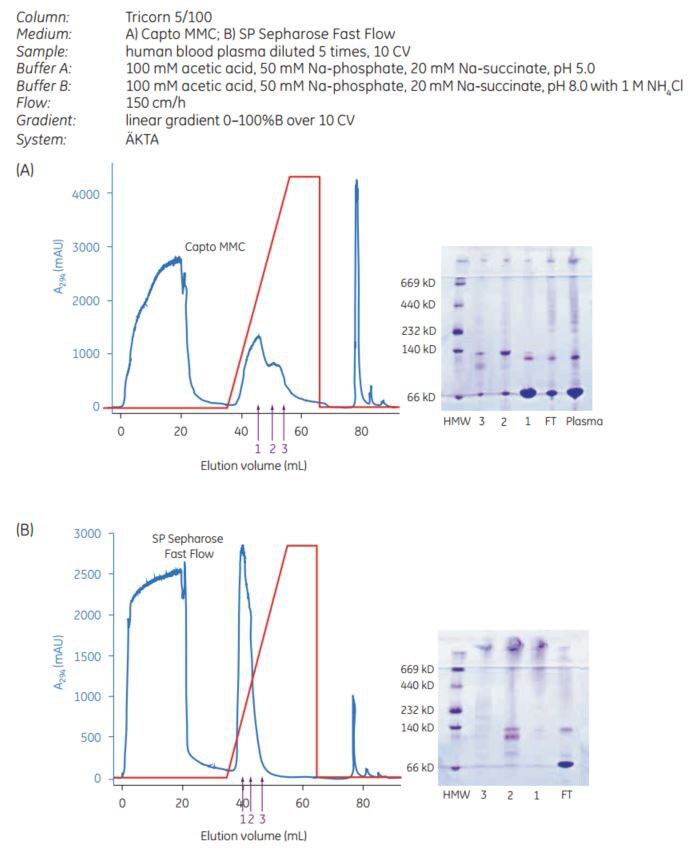
Figure 3.10. The selectivity of (A) Capto MMC and (B) SP Sepharose Fast Flow was investigated using human blood plasma, as described above. Fractions (indicated with arrows) and the flowthrough pool (FT) were analyzed on native PhastGel™ gradient 8%-25% and Coomassie™ stained. High molecular weight marker (HMW, Cytiva) and unfractionated plasma sample were also applied to the gels.
In contrast to traditional cation exchangers, Capto MMC may bind proteins above the pI of the target protein (Figure 2.5 in Chapter 2, Bind/elute vs flowthrough mode in multimodal chromatography). Therefore, if pH is used for elution, higher pH is required with Capto MMC than with traditional cation exchangers. This is illustrated in the elution screening study shown in Figure 3.11.
The figure compares the results obtained in PreDictor plates with results obtained in columns. The best recovery in the elution step is obtained with a simultaneous change in pH and salt concentration. Identical results are not obtained in the two formats, but the trends as well as the optimal conditions found are the same.
The best recovery is obtained at pH 6.75, which is approximately 2 pH units above the pI of BSA. For further details see application note 28-9277-90, “High-throughput screening for elution conditions on Capto MMC using PreDictor plates.”
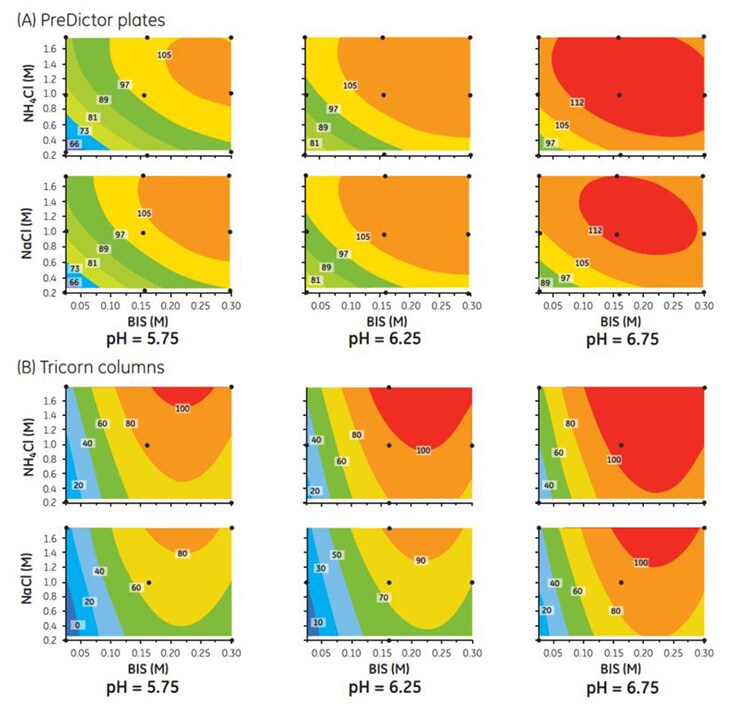
Figure 3.11. Contour plots for the recovery in percent (see labels within each contour plot) of BSA in (A) PreDictor plates and (B) Tricorn column. Recovery is plotted as a function of salt concentration (y axis) and buffer ionic strength (BIS; x axis, running from 0.05 to 0.30 M) at three different pH values for the two salt types NH4Cl and NaCl. The load was 70% of DBC at 10% breakthrough, and the loading buffer was 50 mM sodium acetate, pH 4.75, 250 mM NaCl. Experimental data points are shown as black dots.
Salt type and additives
As previously discussed (Chapter 2, Salt types and additives), the choice of salt type or the use of additives will impact the chromatographic behavior of multimodal media. For example, the recovery of the target molecule is affected by the salt type used, as exemplified in Figure 3.11. The effect of different additives on DBC on Capto MMC is shown in Figure 3.12. In this example, detergents and antifoam agents did not have a significant impact on capacity, while organic solvents and hydrogen bond disruptors had a larger impact.
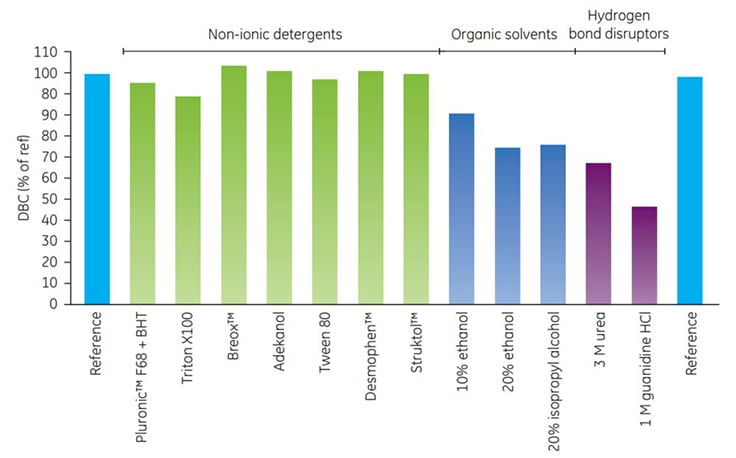
Figure 3.12. Effect of additives on the DBC of BSA on Capto MMC. DBC is plotted as percent of reference run in the absence of additives. BHT = butylated hydroxytoluene.
Binding capacity and recovery can also be influenced by different additives. The effect of urea and organic solvents, ethanol, and isopropyl alcohol on DBC is shown in Figure 3.12. The decreased capacity in the presence of urea and organic modifers suggest that these can be used to improve elution effciency.
Regeneration
For maintenance of the medium, including CIP and storage, see Appendix 2 (Maintenance of media and storage conditions).
Materials
To continue reading please sign in or create an account.
Don't Have An Account?